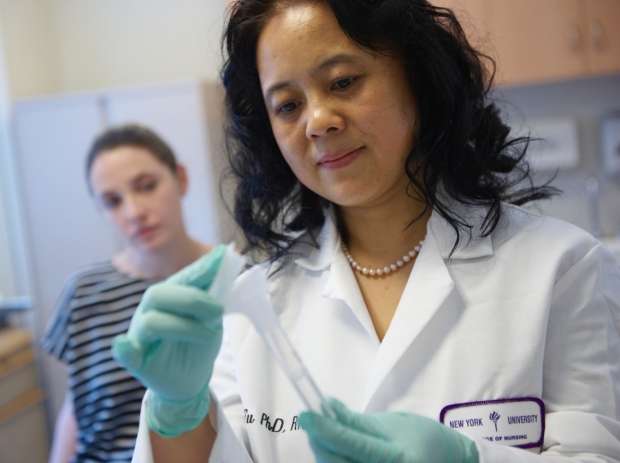Researchers study patients' genetic and susceptibility risk factors for lymphedema

Each year, about 1.38 million women worldwide are diagnosed with breast cancer. Advances in diagnosis and treatment have facilitated a 90-percent, five-year survival rate, among those treated. However, with the increased rate and length of survival following breast cancer, patients face a lifetime risk of developing lymphedema, one of the most distressing and feared late onset breast cancer-related effects.
Lymphedema is an abnormal accumulation of lymph fluid in the ipsilateral body area, or upper limb. This remains an ongoing major health problem affecting more than 40 percent of 3.1 million breast cancer survivors in the U.S. Lymphedema following breast cancer surgery is typically considered to be primarily due to the mechanical injury from surgery. However, recent research has found that inflammation-infection and higher body mass index are also main predictors of lymphedema.
Researchers from New York University Rory Meyers College of Nursing (NYU Meyers), led by Dr. Mei R. Fu, PhD, RN, FAAN, conducted a study, "Precision assessment of heterogeneity of lymphedema phenotype, genotypes and risk prediction," to address this phenomenon and prospectively examine phenotype of arm lymphedema by limb volume and lymphedema symptoms in relation to inflammatory genes in women treated for breast cancer.
The study, published in The Breast, is the first of its kind in exploring associations between genetic susceptibility targeting identified phenotypic risk factors of inflammation and heterogeneous phenotypes of lymphedema.
"It remains puzzling that up to 23% of survivors who only had lumpectomy with sentinel lymph node biopsy of 1 or 2 lymph nodes removed have developed lymphedema, while some survivors who had mastectomy with more than 10 lymph nodes removed have not," said Dr. Fu. "There is a critical need to understand heterogeneity of lymphedema phenotype in relation to assessment of lymphedema phenotype and related biological mechanism."
The study consisted of 136 women with a mean age of 52 with a first time diagnosis of breast cancer (Stage I-III), and were scheduled for surgical treatment of lumpectomy or mastectomy.
The researchers measured data at 4-8 weeks post-surgery and 12 months post-surgery to monitor development of lymphedema during this period. They used lymphedema phenotyping to measure more symptoms than the typical method of observing swelling and limb volume. The symptom phenotyping was important in indicating early stage lymphedema where limb volume cannot be assessed yet.
The researchers found that using symptom phenotyping, prior to surgery, only one participant had more than 8 symptoms and only 18 had 1-7 symptoms. At 4-8 weeks post-surgery all participants had at least one symptom, 53% had 1-7 symptoms, and 46% had more than 8 symptoms, whereas only 16% had arm lymphedema defined by limb volume increase. At 12 months post-surgery 26.5% had more than 8 symptoms and 63% reported 1-7 symptoms, whereas only 22.8% had arm lymphedema as defined by limb volume.
Additionally, prior to surgery, identification of symptom phenotypes was not feasible, as 86% of participants were symptom-free. However, at 4-8 weeks post-surgery 58.1% of participants were classified as the phenotype of impaired limb mobility, with 86% discomfort, and 55.9% fluid accumulation. At 12 months 55.2% of participants were classified as the phenotype of impaired limb mobility with 38.2% pain/discomfort, and 44.1% fluid accumulation.
This data found significant associations between genotypes related to several lymphatic and inflammatory genes and symptom phenotypes of impaired limb mobility, fluid accumulation, and pain/discomfort. The data further provides support for heterogeneity of lymphedema phenotypes, especially phenotype of symptom clusters based on biological mechanisms.
Dr. Fu notes that the sample size and only 12-month period of observation does put limitations on the study.
The evidence from the study supports that interventions to promote lymph fluid flow and optimize body mass index have demonstrated positive effects for phenotype of fluid accumulation. Additionally, this study underscores the need for further research and exploration to advance understanding.
"Precision assessment of heterogeneity of lymphedema phenotype and understanding the biological mechanism of each phenotype through exploration of inherited genetic susceptibility is a logical step for finding a cure for this chronic condition," said Dr. Fu. "Our research team has laid the foundation for, and shown the importance of, further studies on this topic. We hope it will help us gain a better understanding of lymphedema that will eventually lead to a cure."
More information: Mei R. Fu et al. Precision assessment of heterogeneity of lymphedema phenotype, genotypes and risk prediction, The Breast (2016). DOI: 10.1016/j.breast.2016.06.023
















